What better way to remember your ancestors or celebrate friends and family than by planting native trees in Ireland, with Irish Heritage Tree?
An ideal way to honor your family, friends, and Irish ancestry, IrishCentral's Irish Heritage Tree program allows you to plant native trees in Ireland, a living symbol of your bond with Ireland, always and forever, planted in Irish soil. The Irish Heritage Tree program is planting exclusively native Irish trees, including oak, alder, birch, and Scots pine.
Find out more about the Irish Heritage Tree program here
IrishCentral and the Tree Council of Ireland secured locations on a sprawling farm in Co Tipperary and the countryside of West Cork, steeped in history and Irish mysticism.
We're proud to say that our original forest in Co Tipperary is now complete and 3,500 native trees have been planted. Trees are now being planted in our second location near Drimoleague, West Cork
Below the experts from the Tree Council of Ireland share their wisdom on the wonderful native trees that have been planted in Co Tipperary and Co Cork. Join the Irish Heritage Tree program and plant your roots in Ireland.
A history of native trees in Ireland
Around 12,000 years ago, Ireland was covered in snow and ice. This was known as the Ice Age. As the weather became warmer, the snow and ice melted and trees began to grow. The seeds of trees such as hazel and oak were brought here by birds and animals, across the landbridges from Britain and the rest of Europe. The seeds of other trees, such as willow and birch, are so light that they were blown here by the wind.
Eventually, the seas rose, the landbridges were flooded and Ireland became an island. Our native trees are the trees that reached here before we were separated from the rest of Europe. Our most common native trees include oak, ash, hazel, birch, Scots pine, rowan, and willow. Eventually, people brought other trees, such as beech, sycamore, horse chestnut, spruce, larch, and fir to Ireland.
Pedunculate oak
In Irish: Dair ghallda
In Latin: Quercus robur
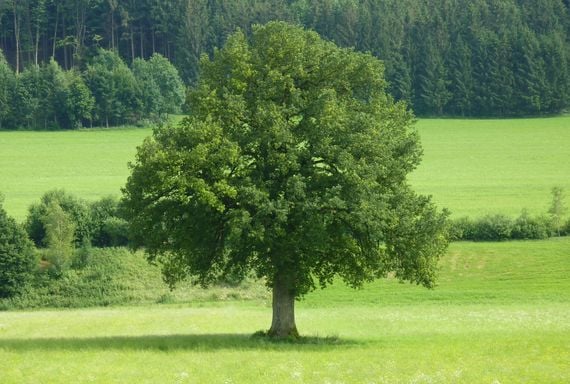
Pedunculate oak.
Once widespread throughout Ireland, centuries of harvesting, with few trees being replaced, means that truly native oak can be hard to find, though there are small woods in most counties. Very often, semi-natural oak woodlands contain a proportion of birch and ash, with hazel, holly, and rowan scattered throughout the understorey. Oak has been harvested for its fine timber for centuries and is much prized for its visual qualities and durability. It is commonly used in the making of furniture, for veneers, and in the manufacture of casks.
The male flowers of oak are borne on rather inconspicuous catkins, which come out just before the leaves, but the seeds – acorns – are far more obvious. Oak trees do not produce a good crop every year, so it is worth gathering plenty in a good year.
The pedunculate or English oak is also considered to be a native tree. It is generally associated with heavy lowland soils and can withstand wet soil in winter. These oak woods are found in Charleville, County Offaly, and Abbeyleix, Co. Laois.
Sessile Oak
In Irish: Diar ghaelach
In Latin: Quercus petraea

Sessile Oak.
The traditional Irish oak is the sessile oak. It is the main species to be found in Ireland’s most familiar woodlands. Sessile oak is found more commonly on poor acid soils, often in hilly regions. These woodlands can be found in Killarney, Co. Kerry, the Glen of the Downs, Co. Wicklow, and Glenveagh, Co. Donegal, to name but a few.
They are important ecologically as habitats for hundreds of invertebrate species along with many species of birds and mammals. Sessile means that the acorns have no stalk while those of the pedunculate oak hang from long stalks.
Once widespread throughout Ireland, centuries of harvesting, with few trees being replaced, means that truly native oak can be hard to find, though there are small woods in most counties. Very often, semi-natural oak woodlands contain a proportion of birch and ash, with hazel, holly, and rowan scattered throughout the understorey.
Alder
In Irish: Fearnóg
In Latin: Alnus glutinosa
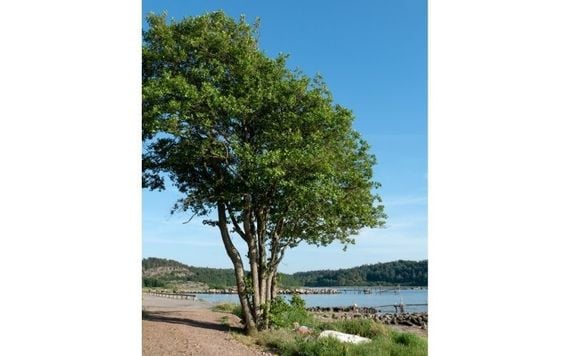
Alder.
One of Ireland’s most traditional and widely distributed trees, alders may be found in damp areas, beside freshwater loughs, and along river banks, where their strong fibrous roots may help to keep the bank in place. Alder woodlands are found in Ross Island, Killarney, County Kerry, and the Gearagh, County Cork, while Grantstown wood, Co. Laois is a rare example of wet woodland on alkaline soil.
Like most trees, alder flowers before the leaves are out, with attractive reddish catkins and small cones that contain the seeds. Alder will grow in most soils and likes wet sites. Given rich damp soil alder will grow rapidly and is a really productive tree for timber. In ancient Ireland sections of alder trunks were used as round shields.
Later, it was used for making clogs and also in the furniture trade where it was known as ‘Irish mahogany’. As it is resistant to decay when submerged in water, alder is used to make sluice gates and other structures along streams, rivers, and canals.
Downy Birch
In Irish: Beith chlúmhach
In Latin: Betula pubescens
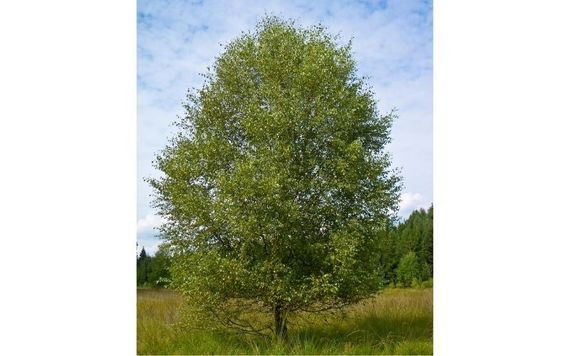
Downy Birch.
There are two types of birch in Ireland, downy and silver. The most usual is the downy birch, which like silver birch is a delicate tree with fine branches and small leaves. The springtime flowers are catkins which stay on the tree and contain the mature seed by autumn.
Birch will grow in poor soils but likes a sunny position. Downy birch is tolerant of wet sites, but silver birch needs good drainage. Birch woods occur widely, especially on marginal soils, lake edges, such as Lough Ennell Co. Westmeath, fens, and on dried out bogs such as Ardkill Bog, Co. Kildare. Birch is typically associated with the Sperrins, growing in peat at the edge of bogs, and on the light sand and gravel soils.
It makes a good ornamental garden tree, as it does not grow too large. Like alder, its seeds are popular with small seed-eating birds such as siskin and redpoll. In early times toghers or walkways, usually across bogland were made from birch. Nowadays, it is more commonly used in making plywood.
Silver Birch
In Irish: Beith gheal
In Latin: Betula pendula
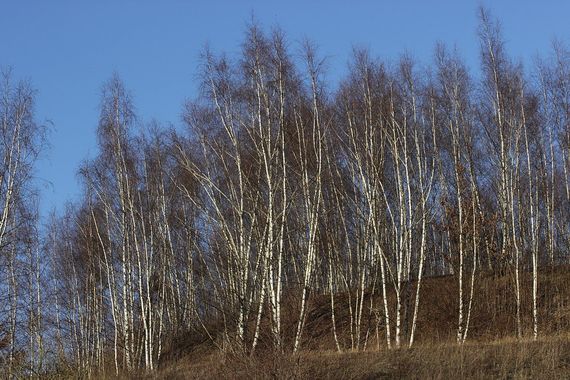
Silver Birch.
There are two types of birch in Ireland, downy and silver. The most usual is the downy birch, which like silver birch is a delicate tree with fine branches and small leaves. The springtime flowers are catkins which stay on the tree and contain the mature seed by autumn.
Birch will grow in poor soils but likes a sunny position. Downy birch is tolerant of wet sites, but silver birch needs good drainage.
Ash
In Irish: Fuinseog
In Latin: Fraxinus excelsior
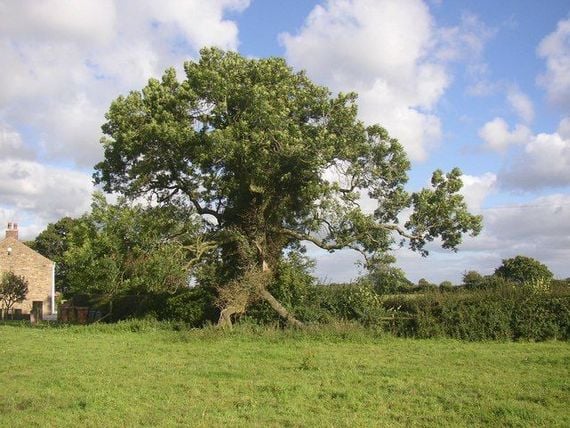
Ash.
Ash is the commonest tree in Irish hedgerows and is also a traditional woodland species. It will grow in a range of soils, not acid, and prefers well-drained sites. Ash woods are found in the Burren, Co Clare, and Hanging Rock in South Fermanagh.
The flowers are very dark, almost black, and may be seen before the leaves develop – ash is one of the last trees to come into leaf and is one of the first to lose its leaves in autumn. The seeds are clumps of winged keys. The pale dense timber makes good firewood and is also used for hurley sticks, snooker cues, and furniture.
Scots Pine
In Irish: Péine albanach
In Latin: Pinus syvestris
Scots Pine.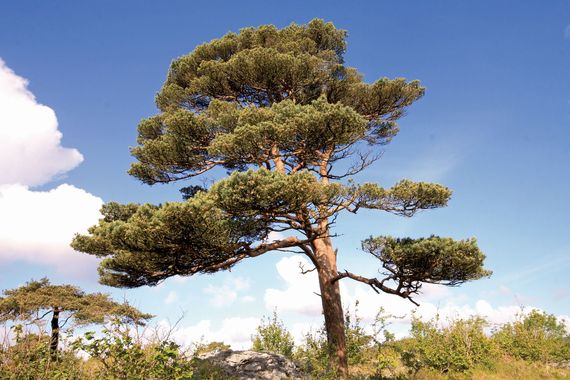
Originally a native tree. Pollen found in soil samples from bogs indicates that Scots pine was widespread in Ireland thousands of years ago. Human impact and the gradual change to a warmer, wetter climate led to its decline, and it may even have died out completely. Pine stumps have been found in bogs, standing where they grew, 7,000 years ago, before the formation of the peat. Most of the pines around the countryside now were imported from Scotland and planted over the last 150 years.
Efforts have been made to reintroduce this once native species as in some situations it is fitting that Scots pine be encouraged. It can be grown on marginal land where other species of tree would not survive. It also matures quicker and produces more versatile wood than broadleaf trees. Even though it is a coniferous tree, it nonetheless supports a wide variety of wildlife as habitat diversity changes in line with canopy closure. Our native red squirrel prefers the seeds of this tree than any other.
H/T: Tree Council of Ireland.
* Originally published in Jan 2021. Updated in 2024.



